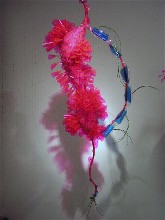
After reading about Robert Rauschenberg in New York in the Philadelphia Inquirer I have to respond by writing about what’s up in Philly, and it’s new work and it’s brilliant (in the British sense, my dears).
In Vox Populi’s “Parts to the Whole,” independent curator Elizabeth Grady has brought together a group show of utterly fresh-looking work from 11 artists, one of them a Vox regular. It’s the kind of show we traipse around Chelsea hoping to discover (Jae Hi Ahn, “Sea Flowers (Pink #2)”).
There’s so much great stuff to see that I couldn’t edit down my pictures, so I put them all up on my flickr site with labels so you could browse through. I see Roberta also has her photos up, so here’s a link to her Flickr site.
The premise to the show is that each piece is made of multiple parts, not necessarily matching. It’s taking the idea of art-world multiples away from the minimalist industrial clones of Allan McCollum, say, and putting it back into the hand-crafted.
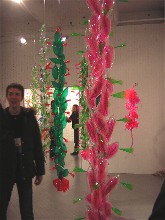
So the plastic, high-industrial colors of Jae Hi Ahn’s “Sea Flowers,” a sort of kelp forest of virtual eye candy that you can walk through, are assembled of many small, hand-assembled pieces, and the resulting objects are then assembled as an installation (image, “Sea Flowers”).
Ahn’s gorgeous pinks and greens are reason enough to see the show, and they remind me of the giant plastic bead hanging ornaments of Susan Chrysler White that we saw at the Affordable Art Fair–decorative, delicate and flamboyant all at once. But Ahn uses surprising materials and methods, making forms that spring from nature, not from household decorations. And in so doing, she glorifies something over which we, as humans, have no control.
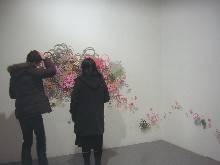
Ahn’s various creations are paired with local artist Nami Yamamoto’s “Primordial Soup,” and the pairing seems just right, both visually and content-wise. Yamamoto said she was interested in how bubbles, when they attach to eachother, change their shapes to accomodate the coupling. And don’t we all (image, detail “Primordial Soup #4)?
In another witty pairing, Grady put a pair of gardens in the back room, and they both looks so great together that I wondered if they were part of the same installation.
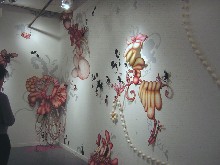
First, Julie Hughes and Pete Goldlust’s flower paintings and polymer clay sculptures threaten with beauty in an installation called “Oviposirehashitor Infidelphia.” Hughes’ gorgeous explosive giant floral paintings on paper gives the feeling of tiny Alice in the caterpillar’s garden. There’s a Victorian microscopic examination of the wonders of nature here. At the same time, the flowers, which stand out from the wall, are embellished by fabulous shadows painted on the wall behind them, creating a wallpaper effect as well as a subtle feeling of menace. Goldlust’s little sculptures of action-figure size goth critters and weird tiny garden gazebos and follies make the scale of the flowers even scarier (image, detail, “Oviposirehashitor Infidelphia”).

Flowing into that installation, Charley Friedman’s epoxy-coated egg shells pinned to the wall create gestural flower stems that wow for the simplicity of the concept and the material. The shells practically glow, and the yolk-coated shells punctuate the delicacy of the white-on-white installation. Spring is here (image, detail, “Flower Garden”).
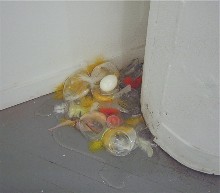
And tucked in a corner of the room, Bethany Bristow, whose work we saw at Scope last year, plays off of both these installations with lots of yellow feathers, her bottle pieces, and her corn syrup puddles, with one of Friedman’s egg shells on top, stuffed chicken feathers under glass. More spring to brighten up the winter gloom. Bristow has her feather-and-glass confections tucked in a number of places around the gallery. My personal fave, besides this one, was the one on the corner of the counter, a place for beers to be served along with sheafs of papers telling about the show, the artists and the pieces, and not a normal place for art (Bristow’s “Wander” in the garden room).
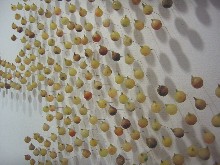
Her use of corn syrup is in keeping with David Meyer’s flour and acrylic giant cast pill shapes on the flour, “Plausible Certainty,” and with Ahn’s “Ingredients” piece, made of latex, boiled salt water with spices (soy sauce, tea, seseame oil, coffee and hot pepper powder) or her delicate “White Fungus,” of rice flower and glue. I am reminded of Ed Ruscha’s making prints from berry juice, but the pieces in this show take the food use one step further. I’m also seeing these safe materials as a kind of counter-toxicity movement in an art world where poisonous epoxy has taken the health threat of art materials to new levels. There’s something so very odd, going back to Friedman’s “Flower Garden,” about coating egg shells and yolk, traditional cross-cultural symbols of life and birth, with deadly epoxy (image, detail, “Ingredients,” by Ahn, which spreads across the wall like a sea creature, a star fish or amoeba).
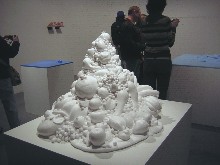
Just a few more notes I can’t let pass about the show. David Baskin’s “Fruit Knoll” looks like a wild, Baroque version of Stephen Robins’ classical concrete fruit bowls at the Convention Center. Baskin’s fruit is uncontained and ultra-sexy. Even his smaller arrangements have a sexiness and fecundity that seems the opposite of nature mort (“Fruit Knoll”).
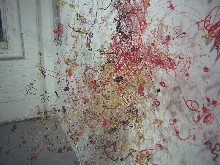
And Gelah Penn’s “Criss Cross,” a tangle that calls up Sarah Sze’s delicate precarious structures and Eva Hesse’s tangles of ropes, holds together what is normally the video lounge at Vox (image, detail, “Criss Cross”).
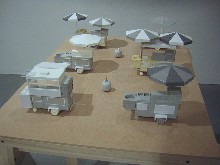
Mike Peter Smith’s toy-inspired constructions highlight man hoist by his own petard, existential little Frankenstein dramas of man confronting his creations. Sometimes the human is visible, sometimes we as the artgoers are the human facing the wonders we hath wrought (image, Smith’s “Vendor Carts”).
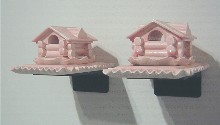
And finally, Jessica Bader’s pair of oxymoronic log cabins combine the romance of roughing it and togetherness with their opposites. The couple live in two different houses and roughing it is not so romantic if the logs are made of porcelain. The anthropomorphic quality of the pink cabins raises lots of questions about romance and its failures (image, “Little Pink Houses for You and Me,” porcelain and glaze).









